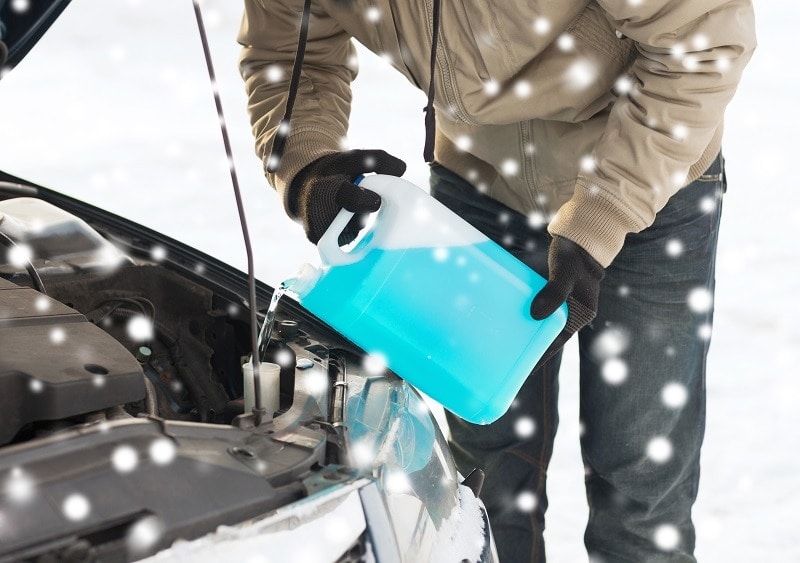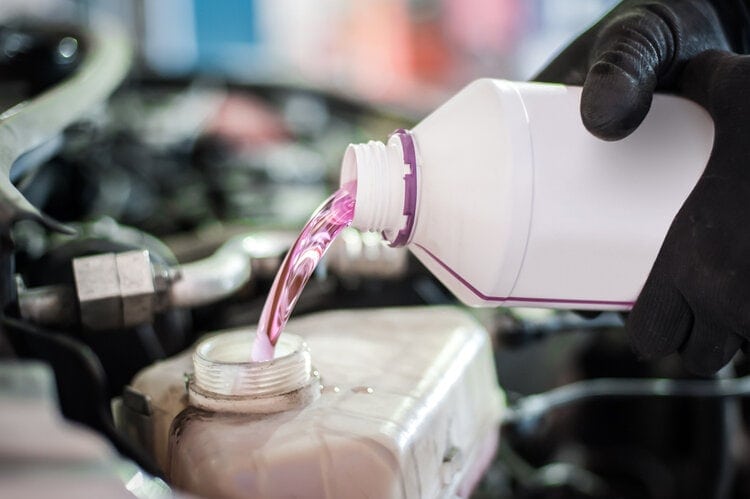How to Dispose of Antifreeze Safely: What You Need to Know
-

- Last updated:


Antifreeze, or engine coolant, is a water-based liquid, but it also contains ethylene glycol, propylene glycol, and methanol, among other substances. It can be toxic to humans and animals, especially if it is consumed. If disposed of incorrectly, it can get into groundwater and drinking water reserves, crops, and it should be disposed of properly to avoid contaminating the ground.
As well as being a serious issue for garages and showrooms, who will often pay to have antifreeze professionally removed, you may need to learn how to dispose of the substance if you flush your engine coolant at home, or if you have suffered a spill while working on your engine.
Car manufacturers recommend changing the antifreeze in your vehicle roughly every 50,000 miles so, while this won’t be too frequent a job, it is a task that some people undertake at home, themselves.
The Dangers of Antifreeze
Antifreeze is water-based but it has several ingredients that are considered toxic to humans and animals. Consumption of the liquid can lead to symptoms like headache, fatigue, lack of coordination, and gastrointestinal distress. Serious symptoms include breathing problems, convulsions, and an inability to urinate. Symptoms can come on gradually, over the space of several hours, and can lead to organ damage and coma. It is important to prevent the ingestion of antifreeze, which means ensuring the proper disposal of this toxic liquid.
How Do You Dispose of Antifreeze At Home?

If you work as a mechanic or in a garage, you should have specific rules and guidelines to follow that will ensure the safe disposal of antifreeze. For those that are looking to dispose of it safely at home, follow these general guidelines.
Safely Test Antifreeze Levels
Park on a level surface, let the engine cool, and unscrew the radiator cap. Ensure that your antifreeze reaches the maximum mark. If it does, then it doesn’t need topping up. Use a coolant tester to check the quality of the antifreeze. Some mechanical problems can cause degradation and contamination of the liquid. The best way to avoid the improper or unsafe disposal of antifreeze is to only change it when necessary.
Find A Hazardous Waste or Recycling Center
If you determine that you need to flush or change the antifreeze in your engine, find a hazardous waste or a recycling center before you change it. Earth 911 has a recycling center locator, which makes it easy to find an appropriate location.
Remember that antifreeze that has become contaminated with gas or oil cannot be recycled and must be taken for hazardous chemical disposal. Non-contaminated antifreeze will usually be accepted by local recycling centers, but you should ring to check they have a tank and to ask how best to transport it.
Use the Proper Equipment When Draining Old Antifreeze
You should use the proper equipment when draining coolant from your engine. This includes safety equipment to protect yourself, such as gloves and goggles, or a full mask. Place a drain pan under the valve before opening it. Only tighten once all of the antifreeze has been allowed to drain out and then safely transfer the old antifreeze into a sealable plastic container and ensure that the lid is secured tightly.
Clean Up Spills Quickly
Spills can happen, and you must act quickly to clear up any antifreeze that does spill on the ground. The longer you leave it, the longer the antifreeze has to soak into the ground and other areas.
Baking soda is appropriate for small amounts of the liquid, while sand is useful on hard surfaces. Cat litter is highly absorbent and it can do a very good job of clearing up larger puddles, although the large size of the litter pellets means that you may need to combine this with sand or another finer material to absorb as much of the coolant as possible.
Once you’ve cleared the litter, sand, or other material out of the way and into a protective container, use paper towels to cover the area. Leave them for several hours to gather up the final remnants and place them in a sealed waste bag. This can be left with your regular waste, but you do need to ensure that it is safe and away from children and animals. Finally, liquid soap can help to get rid of the stain that is left behind by the coolant.
- Related Read: How to Safely Dispose of Old Gas: What You Need to Know!
Secure the Liquid
Once you remove the coolant from your engine, place it into plastic containers that can be easily sealed tight. Ensure that lids are tightly sealed before moving the containers, or you risk them falling over and spilling.
Transport It Safely
Finally, once you have sealed the coolant containers, place them on the floor of your vehicle, ideally in the trunk or on the floor of the back seat. Use cables and cords to keep the containers stable, if necessary, and label the primary ingredient of the antifreeze, as well as the date it was changed. Carefully transport the antifreeze to your recycling center or hazardous waste center.
 FAQ
FAQ
Is It Illegal to Pour Antifreeze Down the Drain?
Coolant has a very sweet taste to it, and this encourages animals to drink it. Pouring antifreeze down the drain means that it will attract wild animals to your drain and to the sewer system to consume it. Glycol and other ingredients can prove highly toxic to animals, so it should not be poured down the drain, even if it is free of other contaminants.
Does Walmart Take Used Antifreeze?
A limited number of Walmarts may accept used antifreeze. They will then use a recycling kit that clears out contaminants and enables them to reuse the antifreeze in another vehicle. Ring the store before carrying any used liquid there for recycling, though, because it is unusual for Walmart to offer this service.
How Long Does Antifreeze Stay in the Ground?
Antifreeze can be made of any of several different primary ingredients, including glycol or ethylene glycol. This takes approximately 10 days to break down in the air, but it can take several days or even weeks to break down in soil or other ground. During this time, the glycol can get into the roots of grass and plants, killing them or even causing toxicity in crops that spread to humans and animals that eat them.
Can You Dump Antifreeze on The Ground?
Because antifreeze is so toxic and takes so long to break down in the ground, you must soak up any spills and prevent the disposal of antifreeze into the ground. Spills do happen, and as long as you soak up the offending coolant, and do not intentionally pour used coolant into the ground, it shouldn’t be too dangerous.
Final Thoughts
Antifreeze is toxic to humans and animals, and it can poison crops and plants. It should not be poured into the ground or down drains, and you should find either a recycling center or a toxic waste disposal center, according to whether the coolant has any other contaminants present, before safely draining, storing, and transporting the toxic liquid to its final destination.
See Also:
- How to Dispose of Fluorescent Tubes Safely: What You Need to Know
- How to Safely Dispose of Engine Coolant: What You Need to Know
Featured Image Credit By: Syda Productions, shutterstock
Contents

 FAQ
FAQ